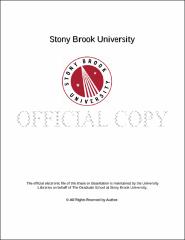| dc.identifier.uri | http://hdl.handle.net/11401/78338 | |
| dc.description.sponsorship | This work is sponsored by the Stony Brook University Graduate School in compliance with the requirements for completion of degree | en_US |
| dc.format | Monograph | |
| dc.format.medium | Electronic Resource | en_US |
| dc.format.mimetype | Application/PDF | en_US |
| dc.language.iso | en_US | |
| dc.type | Dissertation | |
| dcterms.abstract | Noise and power efficiency are two critical issues in modern integrated circuits (ICs) that highly impact the system performance. Due to the high density of circuits, different circuit modules are integrated on the same die. Specifically, in a mixed-signal environment, switching noise due to substrate coupling propagates from digital circuits to analog parts. Furthermore, analog circuits also suffer from the intrinsic device noise such as thermal, flicker and shot noise. Thus, a challenging issue during the design process of analog circuits is the evaluation of the dominant noise source. An analysis flow is proposed to understand the dominance characteristics of switching noise and device noise in two commonly used amplifiers. The frequencies at which the input device and switching noise are equal have been determined to provide guidelines for signal isolation process. Power supply noise is known as a primary source of switching noise. Voltage regulators are typically used to ensure stable power supply voltage with tolerable noise. A buck voltage regulator with 87\% power efficiency is introduced in this thesis. Typical buck converters with on-chip inductors have high switching frequency to reduce the stringent inductor size. In this research, the voltage regulator consists of spiral inductors that are embedded within the flip-chip package structure. Inductors with relatively high quality factors are built by utilizing the flexibility of the package space, enabling a relatively low switching frequency of the buck converter. Low switching frequency reduces the dynamic loss, thereby increasing the overall conversion efficiency of the regulator. The proposed methodologies to manage noise are utilized while developing ultrasound transducers with application to bone density diagnosis and treatment. Furthermore, these methodologies can also serve as a framework to minimize the undesirable artifacts during the ultrasound B-mode imaging process. Several research studies related to ultrasound transducer development and front-end circuit design are introduced in the second part of this thesis. Ultrasound scanning is noninvasive compared to other medical imaging techniques such as computerized tomography (CT) and magnetic resonance imaging (MRI) scan. Ultrasound therefore can be applied to human beings on a daily basis for bone density treatment. A software controlled flexible ultrasound system with two-dimensional (2-D) dual array transducer is proposed for noninvasive bone density diagnosis and bone loss treatment. Transmitting (Tx) transducer elements are divided into sub-blocks to excite ultrasound signals in sequence to significantly decrease the system complexity while maintaining beam pattern properties through signal processing at receiving (Rx) side. Apodization is also applied to reduce side lobes and to make the resolution in the field of view (FOV) more uniform. A 5 by 5 phased array low intensity pulse ultrasound system is developed for therapeutic purpose to prevent bone density loss as well as enhance nonunion bone fracture. Electrical pulses generated from the embedded system based electrical control box are converted into ultrasound signals and are excited in a certain time sequence to reach the focal point simultaneously. Sufficient energy intensity is achieved with an ultrasound pulse that has a duty cycle less than 12\%. Dynamic targets are realized to accumulate energy to a specific area. The proposed methodologies in this thesis enable robust ultrasound transducers that can be used for enhanced bone density diagnosis and treatment. | |
| dcterms.available | 2018-07-09T13:38:31Z | |
| dcterms.contributor | Salman, Emre. | en_US |
| dcterms.contributor | Salman, Emre | en_US |
| dcterms.contributor | Stanacevic, Milutin | en_US |
| dcterms.contributor | Qin, Yi-Xian | en_US |
| dcterms.contributor | Guo, Brian. | en_US |
| dcterms.creator | Gan, Zhihua | |
| dcterms.dateAccepted | 2018-07-09T13:38:31Z | |
| dcterms.dateSubmitted | 2018-07-09T13:38:31Z | |
| dcterms.description | Department of Electrical Engineering. | en_US |
| dcterms.extent | 152 pg. | en_US |
| dcterms.format | Monograph | |
| dcterms.identifier | http://hdl.handle.net/11401/78338 | |
| dcterms.identifier | Gan_grad.sunysb_0771E_13480.pdf | en_US |
| dcterms.issued | 2017-08-01 | |
| dcterms.language | en_US | |
| dcterms.provenance | Submitted by Jason Torre (fjason.torre@stonybrook.edu) on 2018-07-09T13:38:31Z
No. of bitstreams: 1
Gan_grad.sunysb_0771E_13480.pdf: 6258324 bytes, checksum: 407a6f01f43a558be6a76b17762aab9a (MD5) | en |
| dcterms.provenance | Made available in DSpace on 2018-07-09T13:38:31Z (GMT). No. of bitstreams: 1
Gan_grad.sunysb_0771E_13480.pdf: 6258324 bytes, checksum: 407a6f01f43a558be6a76b17762aab9a (MD5)
Previous issue date: 2017-08-01 | en |
| dcterms.subject | Electrical engineering | |
| dcterms.subject | Acoustics | |
| dcterms.subject | Biomedical | |
| dcterms.subject | Power efficiency | |
| dcterms.subject | Switching noise | |
| dcterms.subject | Ultrasound | |
| dcterms.title | Design Methodologies to Manage Switching Noise with Applications to Biomedical Acoustic Systems | |
| dcterms.type | Dissertation | |

